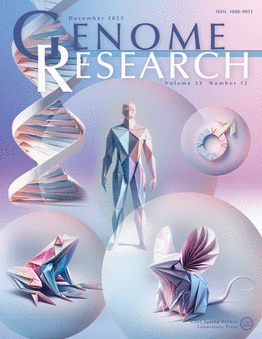The chromatin landscape of the histone-possessing Bacteriovorax bacteria
IF 6.2
2区 生物学
Q1 BIOCHEMISTRY & MOLECULAR BIOLOGY
引用次数: 0
Abstract
Histone proteins have traditionally been thought to be restricted to eukaryotes and most archaea, with eukaryotic nucleosomal histones deriving from their archaeal ancestors. In contrast, bacteria lack histones as a rule. However, histone proteins have recently been identified in a few bacterial clades, most notably the phylum Bdellovibrionota, and these histones have been proposed to exhibit a range of divergent features compared to histones in archaea and eukaryotes. However, no functional genomic studies of the properties of Bdellovibrionota chromatin have been carried out. In this work, we map the landscape of chromatin accessibility, active transcription and three-dimensional genome organization in a member of Bdellovibrionota (a Bacteriovorax strain). We find that, similar to what is observed in some archaea and in eukaryotes with compact genomes such as yeast, Bacteriovorax chromatin is characterized by preferential accessibility around promoter regions. Similar to eukaryotes, chromatin accessibility in Bacteriovorax positively correlates with gene expression. Mapping active transcription through single-strand DNA (ssDNA) profiling revealed that unlike in yeast, but similar to the state of mammalian and fly promoters, Bacteriovorax promoters exhibit very strong polymerase pausing. Finally, similar to that of other bacteria without histones, the Bacteriovorax genome exists in a three-dimensional (3D) configuration organized by the parABS system along the axis defined by replication origin and termination regions. These results provide a foundation for understanding the chromatin biology of the unique Bdellovibrionota bacteria and the functional diversity in chromatin organization across the tree of life.拥有组蛋白的杆菌的染色质景观
组蛋白传统上被认为仅限于真核生物和大多数古细菌,真核生物的核糖体组蛋白来源于它们的古细菌祖先。相比之下,细菌通常缺乏组蛋白。不过,最近在几个细菌支系中发现了组蛋白,其中最著名的是Bdellovibrionota菌门,这些组蛋白与古细菌和真核生物中的组蛋白相比表现出一系列不同的特征。然而,目前还没有对Bdellovibrionota染色质的特性进行功能基因组研究。在这项工作中,我们绘制了 Bdellovibrionota 的一个成员(Bacteriovorax 菌株)的染色质可及性、活性转录和三维基因组组织图谱。我们发现,与在一些古生菌和基因组紧凑的真核生物(如酵母)中观察到的情况类似,Bacteriovorax 染色质的特点是启动子区域周围的可及性优先。与真核生物类似,细菌染色质的可及性与基因表达呈正相关。通过单链DNA(ssDNA)分析绘制活性转录图显示,与酵母不同,但与哺乳动物和苍蝇启动子的状态相似,杆菌启动子表现出非常强的聚合酶暂停。最后,与其他不含组蛋白的细菌类似,Bacteriovorax 基因组也是由 parABS 系统沿复制起源和终止区所确定的轴线组织的三维(3D)结构。这些结果为了解独特的 Bdellovibrionota 细菌的染色质生物学以及整个生命树染色质组织的功能多样性奠定了基础。
本文章由计算机程序翻译,如有差异,请以英文原文为准。
求助全文
约1分钟内获得全文
求助全文
来源期刊

Genome research
生物-生化与分子生物学
CiteScore
12.40
自引率
1.40%
发文量
140
审稿时长
6 months
期刊介绍:
Launched in 1995, Genome Research is an international, continuously published, peer-reviewed journal that focuses on research that provides novel insights into the genome biology of all organisms, including advances in genomic medicine.
Among the topics considered by the journal are genome structure and function, comparative genomics, molecular evolution, genome-scale quantitative and population genetics, proteomics, epigenomics, and systems biology. The journal also features exciting gene discoveries and reports of cutting-edge computational biology and high-throughput methodologies.
New data in these areas are published as research papers, or methods and resource reports that provide novel information on technologies or tools that will be of interest to a broad readership. Complete data sets are presented electronically on the journal''s web site where appropriate. The journal also provides Reviews, Perspectives, and Insight/Outlook articles, which present commentary on the latest advances published both here and elsewhere, placing such progress in its broader biological context.
 求助内容:
求助内容: 应助结果提醒方式:
应助结果提醒方式:


